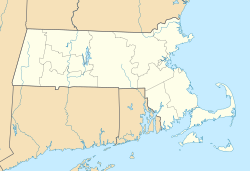Joseph Perkins House | |
 | |
| Location | 297 Howe Street, Methuen, Massachusetts |
|---|---|
| Coordinates | 42°45′40″N71°10′8″W / 42.76111°N 71.16889°W |
| Built | 1840 |
| Architectural style | Greek Revival |
| MPS | Methuen MRA |
| NRHP reference No. | 84002416 [1] |
| Added to NRHP | January 20, 1984 |
The Joseph Perkins House is a historic house in Methuen, Massachusetts. From its external appearance, it is a Greek Revival 1.5-story wood-frame house, which appears to have been built around 1840; however, it has also been assigned construction dates as early as 1752 by local historians. It exhibits Greek Revival features, with corner pilasters, a deep cornice, and a center delighted doorway framed by an entablature supported by pilastered. It is named for a farmer who owned the property in the 19th century. [2]
The property was listed on the National Register of Historic Places in 1984. [1]


